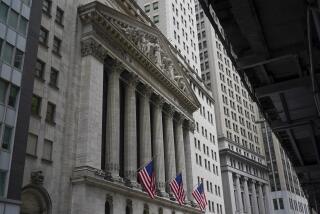U.S. stocks plunge after China sell-off on fears of weak global growth

Trader Gregory Rowe works on the floor of the New York Stock Exchange on Monday.
Investors got a stark reminder Monday to stay buckled up in 2016.
After a roller-coaster ride last year, global stock prices fell sharply in response to another rout on the Chinese stock market amid persistent worries that China’s economy is faltering and that Chinese officials are struggling to do much about it.
Rising tensions between Saudi Arabia and Iran — creating fresh concern about Middle East oil supplies — and a report of lackluster U.S. manufacturing added to Wall Street’s bearish mood.
But some analysts cautioned against looking too far ahead based on one session, especially with the U.S. economy still showing modest growth.
“I don’t think this is setting the tone for the year,” said Art Hogan, chief market strategist in New York for Wunderlich Securities.
Nicholas Lardy, who has written several books on the Chinese economy, said investors overreacted to the latest report of China’s shrinking manufacturing sector.
“It’s just been going down, down, down,” said Lardy, a senior fellow at the Peterson Institute for International Economics, noting that government data have shown Chinese industrial growth slowing for 18 of the last 19 quarters.
Still, the new report, and the reaction to it by the Chinese stock market, had a psychological effect on investors around the world, he said.
See more of our top stories on Facebook >>
“People wake up on a Monday morning and read that the Shanghai [index] is down 7%, and they sell,” Lardy said.
After seeing prices plummet in Asia and Europe, investors on Monday drove the Dow Jones industrial average down 276.09 points, or 1.6%, to 17,148.94. The blue-chip gauge had been down more than 450 points early in the day but a late upturn helped cut the losses.
The broader Standard & Poor’s 500 index tumbled 31.28 points, or 1.5%, to 2,012.66, and the tech-heavy Nasdaq composite index lost 104.32 points, or 2.1%, to 4,903.09.
Stocks across nearly all industries were hit hard. Amazon.com Inc. fell 5.8%, home builder D.R. Horton Inc. dropped 5.1%, Delta Air Lines Inc. fell 4% and consumer-products giant Johnson & Johnson lost 2.2%.
Monday’s U.S. trading was orderly, not panic driven, and in some ways the sell-off was familiar.
A similar plunge in Chinese stocks in August set off one of Wall Street’s wildest rides in years, with the Dow Jones industrials first plunging 1,000 points one morning before they shot back up 1,000 points over two days later in the week.
The Dow eventually posted a 2.2% loss for all of 2015, while the S&P 500 fell 0.7% and the Nasdaq rose 5.7% for the year.
Market trackers had warned of more volatility entering 2016. But what seems to particularly unnerve investors as they look ahead is that China doesn’t appear to have arrested the economic and financial markets problems that keep disrupting markets abroad.
Indeed, China’s latest step might have exacerbated the problem. China on Monday implemented “circuit breakers” that temporarily stop trading if prices drop by certain levels, similar to what U.S. markets use.
China halted trading Monday with more than an hour left in the session when its benchmark Shanghai composite index fell 7%.
But there was speculation that China’s circuit breakers might have spawned some of the heavy selling among anxious traders worried about unloading their positions before trading stopped.
“It could have been that once the market started falling, people rushed to sell because they didn’t want to get locked into the market,” said David Loevinger, a top Asia strategist at TCW Group, a Los Angeles investment firm.
Growth in China’s economy has been declining steadily the last several years as Chinese leaders try to transform the economy to suit a more mature developing nation. China wants to shift to a consumer-driven economy from one largely fueled by exports.
But the transition has been difficult. The Chinese economy expanded at a 6.9% annual rate from July through September 2015, well below the torrid double-digit pace of a few years ago.
“Investors keep running into having their expectations” for higher growth in China “meet a different reality,” said John Bollinger, president of Bollinger Capital Management in Redondo Beach.
“China is still growing, it’s just not growing at the rate it used to, and the world is disappointed with that,” he said.
Those growth rates are the envy of much of the world — they are more than triple those of the U.S. economy and more than double the world’s overall production. But they are well below the levels that vaulted the Chinese economy to the world’s second-largest and a major driver of global growth.
In response, Beijing’s leaders have tried various tactics including devaluing the Chinese currency last summer. But that helped trigger financial market turmoil as well.
New concerns flared Monday as a closely watched private report on China’s manufacturing sector showed that conditions worsened in December. The purchasing-managers’ index produced by Caixin Insight Group indicated that China’s factory sector has been contracting for five straight months.
The market also was skittish from “more major geopolitical instability entering the new year,” Hogan said.
He was referring to how Bahrain, Sudan and the United Arab Emirates joined Saudi Arabia in severing or downgrading diplomatic ties with Iran after the Saudis executed a Shiite cleric, sparking Iranian outrage.
“There’s a fear of a disruption to oil supplies in the Middle East” if the situation worsens, Hogan said.
But the price of the benchmark U.S. crude oil, after surging above $38 a barrel early in the session, erased those gains and ended with a 28-cent decline at $36.76 a barrel on the New York Mercantile Exchange.
Meanwhile, the Institute for Supply Management said its purchasing-managers index for U.S. manufacturing companies declined to 48.2 in December from 48.6 the prior month.
A reading of less than 50 indicates that the sector is contracting and November was the first time that the index fell below that level in three years.
The report “is not a recession warning for the overall economy, but factory output is clearly sputtering and will not be one of the much-needed engines for growth this year,” said Chris Rupkey, chief financial economist at Union Bank in New York.
Traders seeking a safer alternative to stocks bid up Treasury bond prices, sending their yields lower. The yield on the 10-year Treasury fell to 2.24%.
The euro was little changed against the dollar at $1.083.
Twitter: @PeltzLATimes
Twitter: @JimPuzzanghera
ALSO
‘Mr. Six’ crosses $100 million, tops China box office
China’s Wanda in talks to buy Legendary Entertainment
CES kicks off with prediction that global tech sales will fall 2% this year








